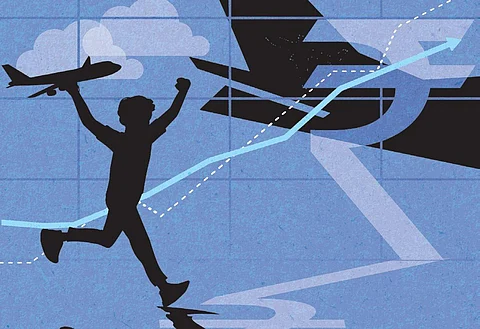

The Indian aviation industry is booming. All over the country, airports are being inaugurated with glitzy interiors. We have been told that airline companies are ordering thousands of aircraft. Airports are coming up in places that don’t have a proper bus stand. Everything appears so glossy. We have been drilled with propaganda to believe we are all soaring towards a golden age. And anyone with the fortune or misfortune of remembering the good old days of socialist India would agree that our airports have changed for the better, at least in appearance. Who would want to return to the dusty sheds that AAI used to call airports?
Now, most airports look stylish, at least from the outside. Air travel was a privilege of the rich a few decades ago, but now it is for the common man, who is getting world-class facilities. That is the story we have been told. Some airports have a nice glass facade, some ornamental plants on either side of the road leading to the airport and the drab mosaic floor has been replaced by glistening tiles and potted plants. A few airports have Plaster of Paris or fibre replicas of some art installations or sculptures to promote Indian culture and tradition. No one can deny these are huge improvements over what we used to get.
But the romantic story of the Indian aviation industry ends there. India is one of the booming aviation industries in the world, yet we are told that everyone is making a loss. This is baffling for the common man for whom these airports are supposed to be built. The shabbily run AAI airports of yesteryears and the much-maligned Air India in the public sector were privatised with grand promises like privatisation will cut down the losses in the public sector, bring forth lots of conveniences for the public and make air travel affordable, and so on.
But on December 4, 2023, Union Minister VK Singh, had given a written response in the Rajya Sabha that only three out of the 14 airports under the Public-Private Partnership (PPP) mode were in profit during 2022-2023. Only Bengaluru, Kochi and Hyderabad made some profit. Ahmedabad airport made the most significant loss, and Mumbai and Delhi weren’t far behind. How can airports like Mumbai or Delhi, which rank among the busiest airports in the world, continue to make losses year after year? Economic experts may be able to answer this paradox with many charts and graphs, but it has left a common man like me scratching my head in confusion.
How can a place that charges Rs 500 for a cup of stale coffee in a paper mug or Rs 600 for a drab sandwich that would make a prison meal taste like fine dining make a loss? The airport looks more like a mall with shops having unpronounceable names stuffed with unaffordable trinkets or unpalatable food. Everyone is paying through their nose. Talk to any shopkeeper in these new glistening airports, and they will start weeping on your shoulders complaining about the high rent they are paying.
Paper towels have been removed from the washrooms to save the environment, India, the earth and the universe in no particular order. Drinking water taps have been replaced by spouts that make us drink like the stray cow from the street tap to save the cost of paper cups. Mumbai or Delhi airports look perpetually crowded. Often, there are no seats to sit on, and people are forced to sit on the floor. Since the airport food is so precious and often costs more than the airfare, many families can be seen sitting on the floor and enjoying a meal packed from home, often inducing nostalgia for the train travel. After the recent hike in price for the cold samosa to astronomical figures, the queue to get into the airport lounge where they serve some free food has started resembling the UN food aid programme after some environmental disaster or civil war.
In most cities, airports charge the highest parking fee. The taxis and autorickshaws have to pay the private airport operator a premium from their meagre earning to enter the airport. Yet, the airport operator is making a loss after all this.
One would imagine that if the airport operator is not making a profit and the public sector is losing money, the airlines would be making a profit. But alas, we are told that they, too, are making huge losses even after making the economy cattle seats so cramped of space and selling Rs 10 peanuts for Rs 300. In short, the government, the airport operator, the shopkeepers inside, the passengers, and the airlines are all making a loss. There is something seriously wrong with the business model. One can only appreciate the benevolence of this monopolistic private airport operator who is doing a patriotic act of running these loss-making airports and is still enthusiastic about taking over more and more airports with even greater losses or the airlines ordering thousands of new aircraft.
An independent Parliament inquiry and audit may be too much to ask and too anti-national a demand. I hope there is some political party foolish enough to speak against these powerful oligarchs and I promise to vote for them, but I doubt it would happen as we have graduated from the kind of democracy that speaks for the people. So, in these good times, one can only plead to the benevolent airport operators and airline companies to kindly reduce the price of coffee to five-star hotel prices, increase leg space by an inch or more, and provide drinking water without saving the environment this much.
Anand Neelakantan
Author of Asura, Ajaya series, Vanara and Bahubali trilogy
mail@asura.co.in